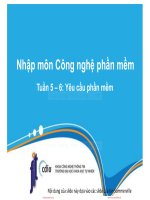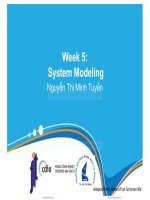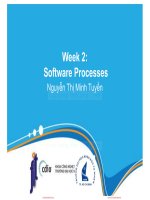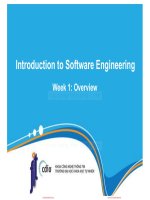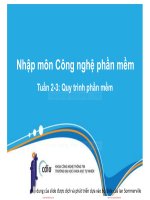Lecture Introduction to software engineering: Week 2 - Nguyễn Thị Minh Tuyền
Bạn đang xem bản rút gọn của tài liệu. Xem và tải ngay bản đầy đủ của tài liệu tại đây (1.06 MB, 55 trang )
Week 2:
Software Processes
Nguyễn Thị Minh Tuyền
CuuDuongThanCong.com
/>
Topics covered
1.
2.
3.
4.
Software process models
Process activities
Coping with change
Process improvement
2
CuuDuongThanCong.com
/>
Definitions
£ What is a process?
£ Four activities that are fundamental to software
engineering?
£ What is process model?
3
CuuDuongThanCong.com
/>
The software process
£ A structured set of activities required to develop a
software system.
£ 4 fundamental activities:
p Specification – defining what the system should do;
p Design and implementation – defining the organization of the
system and implementing the system;
p Validation – checking that it does what the customer wants;
p Evolution – changing the system in response to changing
customer needs.
£ A software process model
p Is an abstract representation of a process.
p Presents a description of a process from some particular
perspective.
4
CuuDuongThanCong.com
/>
Software process descriptions
£ When we describe and discuss processes, we
usually talk about
p the activities in these processes such as specifying a
data model, designing a user interface, etc. and
p the ordering of these activities.
£ Process descriptions may also include:
p Products, which are the outcomes of a process activity;
p Roles, which reflect the responsibilities of the people
involved in the process;
p Pre- and post-conditions, which are statements that
are true before and after a process activity has been
enacted or a product produced.
5
CuuDuongThanCong.com
/>
Plan-driven and agile processes
£ Plan-driven processes are processes where all of
the process activities are planned in advance and
progress is measured against this plan.
£ In agile processes, planning is incremental and it is
easier to change the process to reflect changing
customer requirements.
£ In practice, most practical processes include
elements of both plan-driven and agile
approaches.
£ There are no right or wrong software processes.
6
CuuDuongThanCong.com
/>
Topics covered
1.
2.
3.
4.
Software process models
Process activities
Coping with change
Process improvement
7
CuuDuongThanCong.com
/>
Software process models
£ The waterfall model
p Plan-driven model. Separate and distinct phases of
specification and development.
£ Incremental development
p Specification,
development
and
validation
interleaved. May be plan-driven or agile.
are
£ Reuse-oriented software engineering
p The system is assembled from existing components.
May be plan-driven or agile.
£ In practice, most large systems are developed
using a process that incorporates elements from
8
all of these models.
CuuDuongThanCong.com
/>
The waterfall model
Requirements
definition
System and
software design
Implementation
and unit testing
Integration and
system testing
Operation and
maintenance
9
CuuDuongThanCong.com
/>
Waterfall model phases
£ The main drawback of the waterfall model is the
difficulty of accommodating change after the
process is underway.
£ In principle, a phase has to be complete before
moving onto the next phase.
10
CuuDuongThanCong.com
/>
Waterfall model problems
£ Inflexible partitioning of the project into distinct stages
makes it difficult to respond to changing customer
requirements.
p Only appropriate when the requirements are well-understood
and changes will be fairly limited during the design process.
p Few business systems have stable requirements.
£ Mostly used for large systems engineering projects
where a system is developed at several sites.
p The plan-driven nature of the waterfall model helps coordinate
the work.
11
CuuDuongThanCong.com
/>
£ An important variant of the waterfall model is
formal system development
p Use a mathematical model to specify a system.
p Use mathematical transformations that preserve its
consistency, into executable code.
p Mathematical transformations are correct: a program
generated in this way is consistent with its specification.
£ Formal development processes (B method for
example) are suited to the development of
systems that have stringent safety, reliability, or
security requirements.
12
CuuDuongThanCong.com
/>
Incremental development
Concurrent
activities
Specification
Outline
description
Development
Validation
Initial
version
Intermediate
versions
Final
version
13
CuuDuongThanCong.com
/>
Incremental development benefits
£ The cost of accommodating
requirements is reduced.
changing
customer
p The amount of analysis and documentation that has to be redone
is much less than is required with the waterfall model.
£ It is easier to get customer feedback on the development
work that has been done.
p Customers can comment on demonstrations of the software and
see how much has been implemented.
£ More rapid delivery and deployment of useful software to
the customer is possible.
p Customers are able to use and gain value from the software earlier
than is possible with a waterfall process.
14
CuuDuongThanCong.com
/>
Incremental development problems
£ The process is not visible.
p Managers need regular deliverables to measure
progress. If systems are developed quickly, it is not
cost-effective to produce documents that reflect
every version of the system.
£ System structure tends to degrade as new
increments are added.
p Unless time and money is spent on refactoring to
improve the software, regular change tends to
corrupt its structure. Incorporating further software
changes becomes increasingly difficult and costly.
15
CuuDuongThanCong.com
/>
Integration and configuration
£ Based on systematic reuse where systems are integrated
from existing components or COTS (Commercial-off-theshelf) systems.
£ Reused elements may be configured to adapt their
behaviour and functionality to a user’s requirements
£ Reuse is now the standard approach for building many
types of business system
16
CuuDuongThanCong.com
/>
Types of reusable software
£ Stand-alone application systems (sometimes
called COTS) that are configured for use in a
particular environment.
£ Collections of objects that are developed as a
package to be integrated with a component
framework such as .NET or J2EE.
£ Web services that are developed according to
service standards and which are available for
remote invocation.
17
CuuDuongThanCong.com
/>
Reuse-oriented software
engineering
Application system
available
Software
discovery
Requirements
refinement
Requirements
specification
Software
evaluation
Configure
application
system
Adapt
components
Components
available
Integrate
system
Develop new
components
18
CuuDuongThanCong.com
/>
Advantages and drawbacks
£ Advantages
p Reduced costs and risks as less software is
developed from scratch
p Faster delivery and deployment of system
£ Drawbacks
p requirements compromises are inevitable
¡ this may lead to a system that does not meet the real needs
of users.
p Loss of control over evolution of reused system
elements
19
CuuDuongThanCong.com
/>
Topics covered
1.
2.
3.
4.
Software process models
Process activities
Coping with change
Process improvement
20
CuuDuongThanCong.com
/>
Process activities
£ Real software processes are interleaved sequences of
technical, collaborative and managerial activities with the
overall goal of specifying, designing, implementing and
testing a software system.
£ The four basic process activities of specification,
development, validation and evolution are organized
differently in different development processes.
£ For example:
p In the waterfall model, they are organized in sequence,
p In incremental development, they are interleaved.
21
CuuDuongThanCong.com
/>
Software specification
£ The process of establishing what services are required
and the constraints on the system’s operation and
development.
£ Requirements engineering process
p Feasibility study: Is it technically and financially feasible to
build the system?
p Requirements elicitation and analysis: What do the system
stakeholders require or expect from the system?
p Requirements specification: Defining the requirements in
detail
p Requirements validation: Checking the validity of the
requirements
22
CuuDuongThanCong.com
/>
The requirements engineering process
Feasibility
study
Requirements
elicitation and
analysis
Requirements
specification
Requirements
validation
Feasibility
report
System
models
User and system
requirements
Requirements
document
23
CuuDuongThanCong.com
/>
Software design and implementation
£ The process of converting the system specification into an
executable system.
£ Software design
p Design a software structure that realises the specification;
£ Implementation
p Translate this structure into an executable program;
£ The activities of design and implementation are closely
related and may be inter-leaved.
24
CuuDuongThanCong.com
/>
A general model of the design process
Design inputs
Platform
information
Data
description
Requirements
specification
Design activities
Architectural
design
Interface
design
Component
design
Database design
Design outputs
System
architecture
Database
specification
Interface
specification
Component
specification
25
CuuDuongThanCong.com
/>
